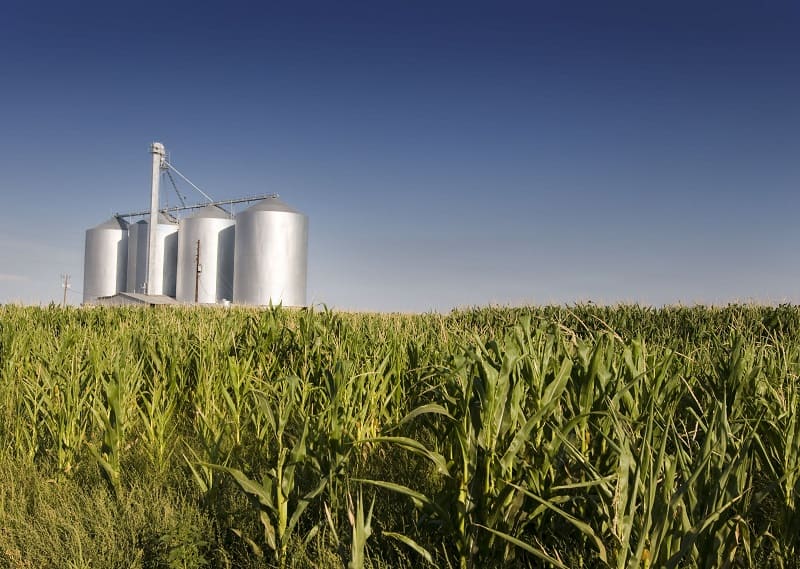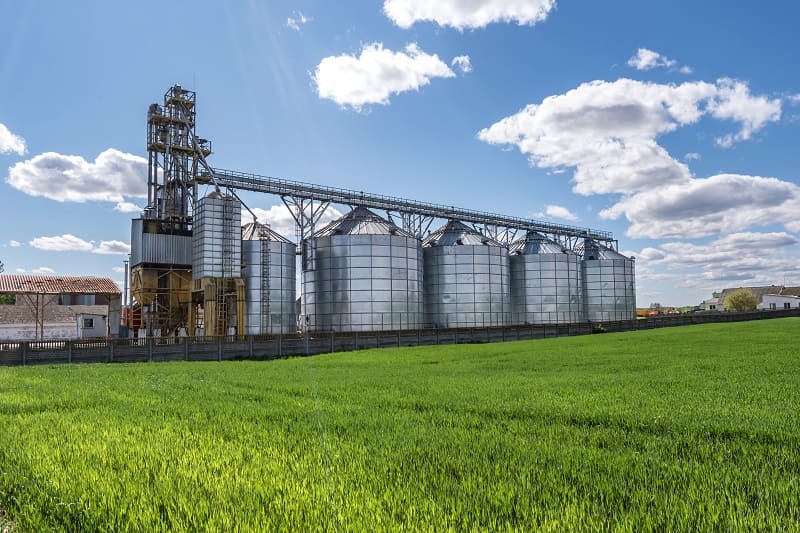Industrial silos are tall, cylindrical storage structures that commonly reach heights of 100 feet or more, and are used in various industries, including agriculture, manufacturing, food and beverage processing, concrete production, mining, and many others that require storing or handling bulk materials. For companies that use this type of storage structure, regular inspections and proper silo cleaning and maintenance is necessary for safety and staying in compliance with governmental and industry regulations — but even more than that, it can help maximize storage capacity, improve material flow, and prevent contamination.
How Does Buildup Happen?
Failing to conduct regular silo cleaning can result in significant build-up and compaction, which is why silo cleaning is a vital part of maintaining your silo. Excessive moisture is usually the culprit of buildup, but some materials are simply more prone to buildup than others. Fine, dusty particulates are more apt to clump and rathole, and sticky, wet products like concrete and cement are also more prone to causing buildup. Vibrations from nearby equipment can also contribute to these problems. For example, in agriculture, if grain is too wet, you run the risk of spoiling the entire load. In food processing, this clumping can attract vermin and pests, which can obviously ruin the product. It can clump and stick to the walls, creating additional problems.
What Problems Can Silo Buildup Cause?
Buildup in silos doesn’t just result in reduced storage capacity or contaminating the product stored inside. It can also make it difficult to remove the product. Silo buildup is a significant problem, but the good news is that it can be remedied with regular silo cleaning.
Reduced Capacity
While it may not seem like not cleaning a silo could reduce capacity by a significant amount, we’ve cleaned silos that saw a reduction of 30% or higher due to buildup, making it essential to clean these structures regularly.
Bridging and Ratholing
When product clumps together, it can form a bridge or blockage over the discharge outlet, preventing the release of the product, a phenomenon known as “bridging.” It can also cause ratholing, a term that describes a situation where the product compacts along the sides of the silo, leaving only a narrow “rathole” like column for product to pass through. Both of these conditions limit operational functionality and reduce capacity.
Contamination
When hydrated or compacted material builds up along the walls of a silo, contamination becomes a real possibility, putting the materials at risk for complete spoilage, costing the company significant money, and jeopardizing customer relationships and reputation. This is primarily a primary concern of dirty silos, especially in food processing plants. Buildup in silos can attract rodents, birds, and other vermin that can contaminate the product, a concern that silos storing feed and grain must be particularly vigilant in monitoring. Additionally, buildup can result in mold or other bacterial growth, rendering the product unusable for food production and spoiling it.
Chemical Reactions
In chemical silos, the buildup of one incompatible chemical with another can result in hazardous chemical reactions, creating a major hazard and significant risk to employees, the business, and the environment. Silos containing chemicals aren’t the only ones at risk for a chemical reaction. Grain bins are also at risk of explosion because the grain dust is highly combustible. With the right environment, a chemical reaction can take place that essentially makes a bomb out of the silo.
Benefits of Regular Silo Cleaning
Regularly cleaning the silos at your industrial facility means that you won’t have to worry about the hazards and risks that an improperly maintained or cleaned silo present. There are several benefits of regular silo cleaning.
Silo Cleaning Maximizes Capacity
Silos play a crucial role for most companies, storing bulk materials. By regularly inspecting and maintaining the silo, including regular silo cleaning, industrial companies utilizing silos as a storage structure can maximize their capacity. This enables cleaner and more efficient operations.
Additionally, operating at full capacity can positively impact the efficiency of other operations that rely on the whole storage, such as peak busy periods during harvest season.
Reduces Contamination Risk
Not only will dirty silos negatively impact their total holding capacity, but as explained, they can also contaminate products or materials, resulting in a host of other problems. Regular cleaning eliminates this risk.
Reduce Unscheduled Downtime
Regular cleanings can help ensure your silo operates as it should. When regular cleanings are conducted and buildup is allowed to occur, it can lead to costly unplanned shutdowns. However, caked-on material is cleaned, allowing for free flow and uninterrupted operations. Cleaning full silos is also a dangerous task, so eliminating this risk by conducting regular silo cleaning is essential.
Stay in Compliance
There are several regulations that industrial facilities with silos must comply with or risk getting fined or shut down. Depending on what the silos store, companies must stay in compliance with various OSHA requirements, EPA regulations, NFPA standards, FDA guidelines, USDA regulations, and other relevant laws.
Best Practices & Solutions

To stay on top of silo inspections, cleaning, and maintenance, many facilities rely on a silo cleaning expert, such as Environmental Remedies. For those handling silo cleaning internally, it is recommended to follow these best practices.
Plan Ahead
Scheduling regular cleaning and inspections at times that are convenient for your business will help keep things running smoothly — just make sure that they are conducted at least once to twice per year.
Follow Safety Protocols
Because silos are considered a confined space, it is necessary to follow confined space protocols regulated by OSHA. Ensure that all controls are in place to minimize unnecessary hazards.
Frequency of Silo Inspections and Silo Cleaning
Silos should be inspected at least annually, according to the National Ag Safety Database, but a best practice is to inspect and thoroughly clean the silo every six months.
Clean an Empty Silo
A silo can’t be thoroughly cleaned unless it is empty. Simply scraping the sides of a silo that still contains product is not a safe or effective method of cleaning a silo.
Dispose of Waste Responsibly
Ensure that any waste material is disposed of correctly and in compliance with relevant regulatory bodies, such as the EPA.
Document Your Silo Cleaning
Keep a record of inspections, any maintenance conducted, and when silo cleaning occurred so you can easily refer back to it — and have it as a record against liability.
Let The Experts Handle Your Silo Cleaning
Whether your crew is busy with other tasks, you’re ready to outsource your silo cleaning, or you’re unsure if you’ve done it effectively, we can help. Contact Environmental Remedies for a silo inspection and cleaning to ensure your silo is operating its best!






